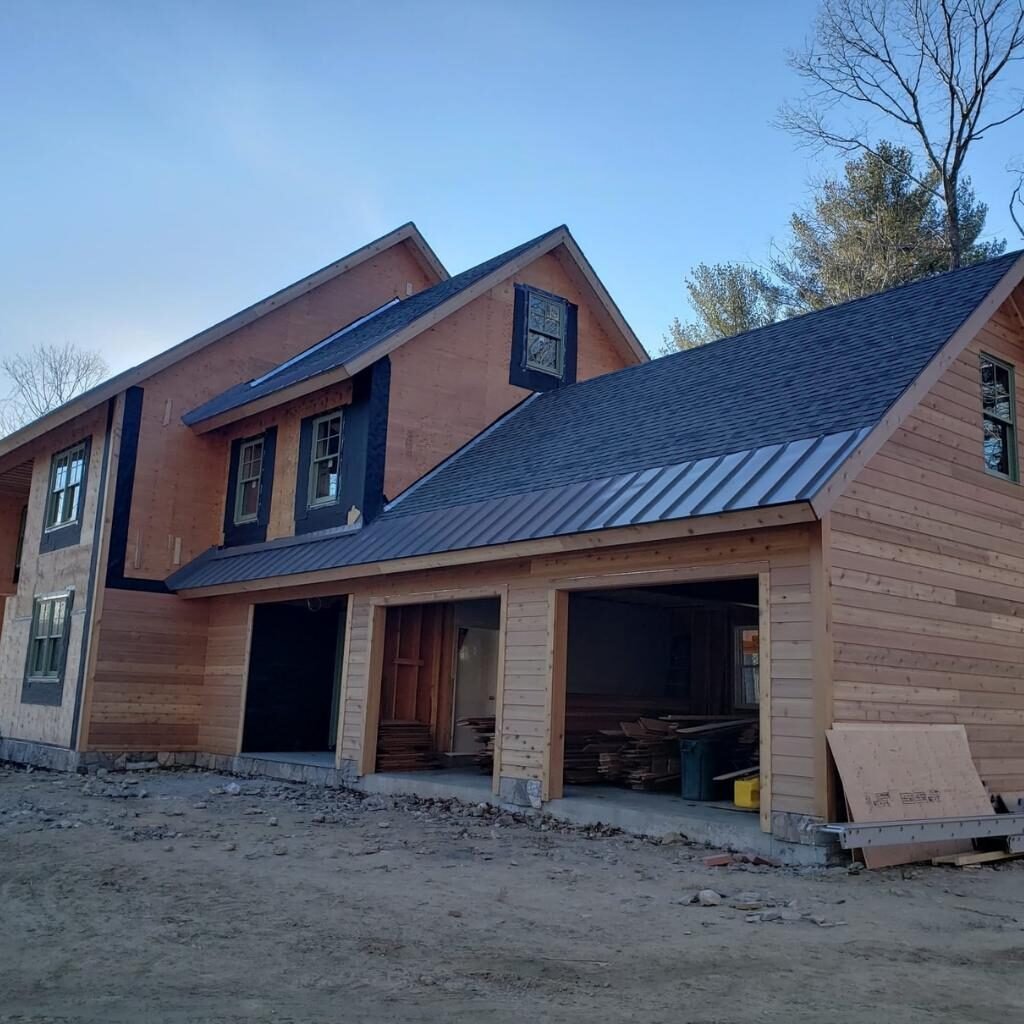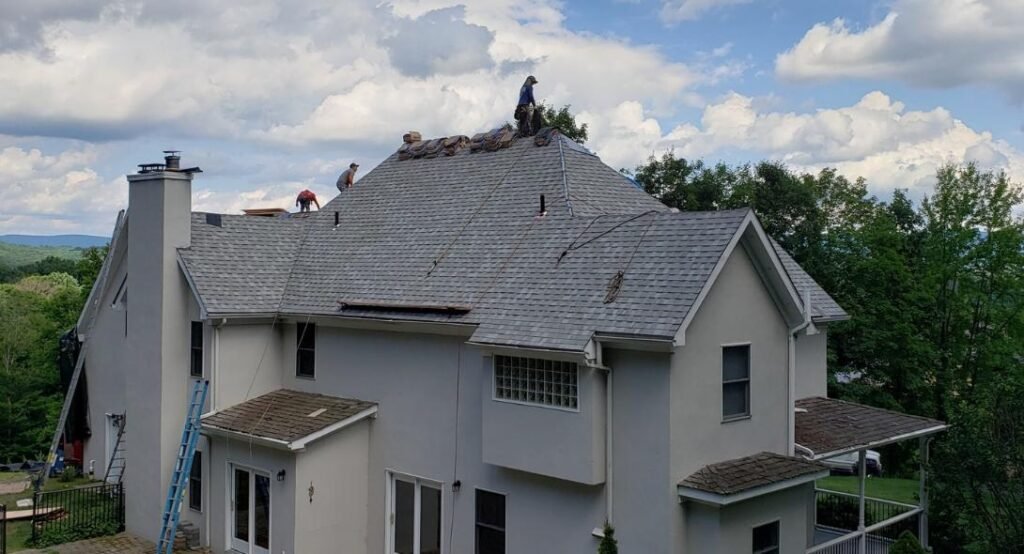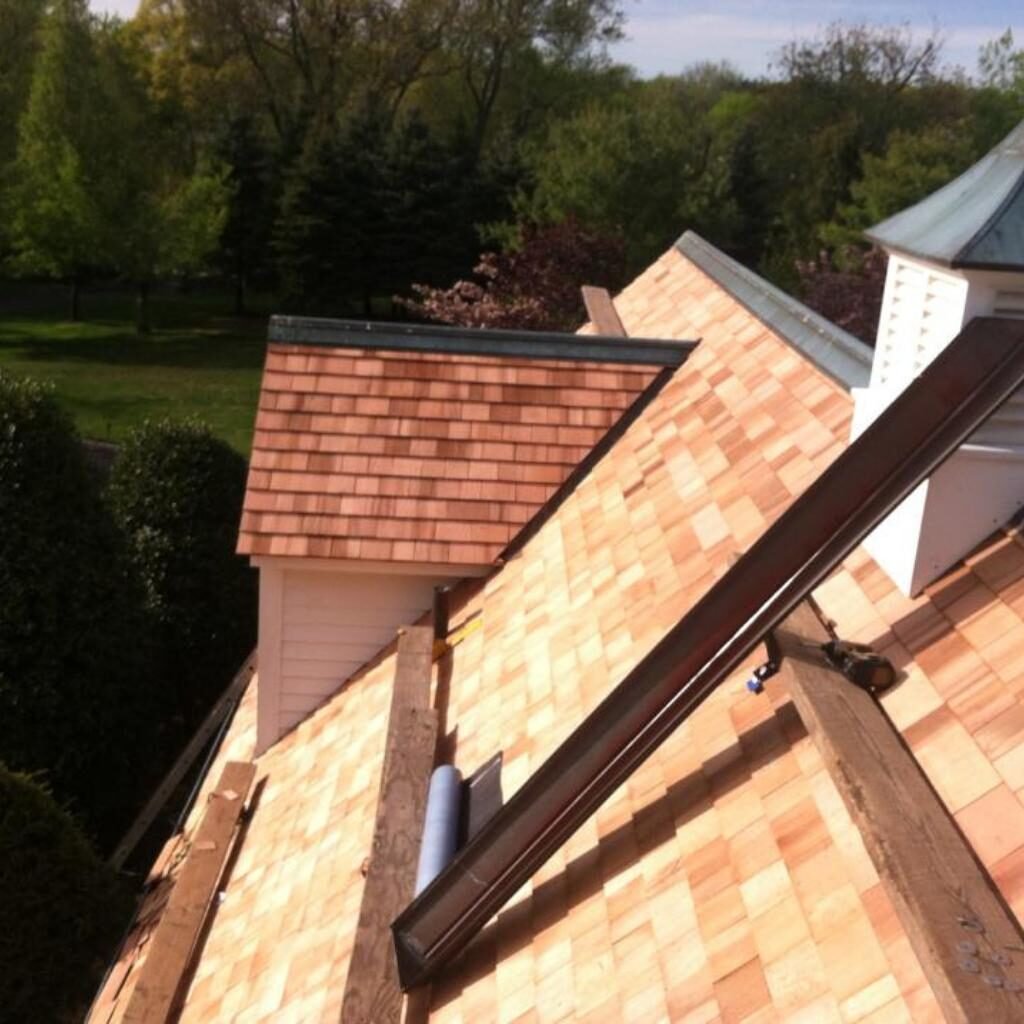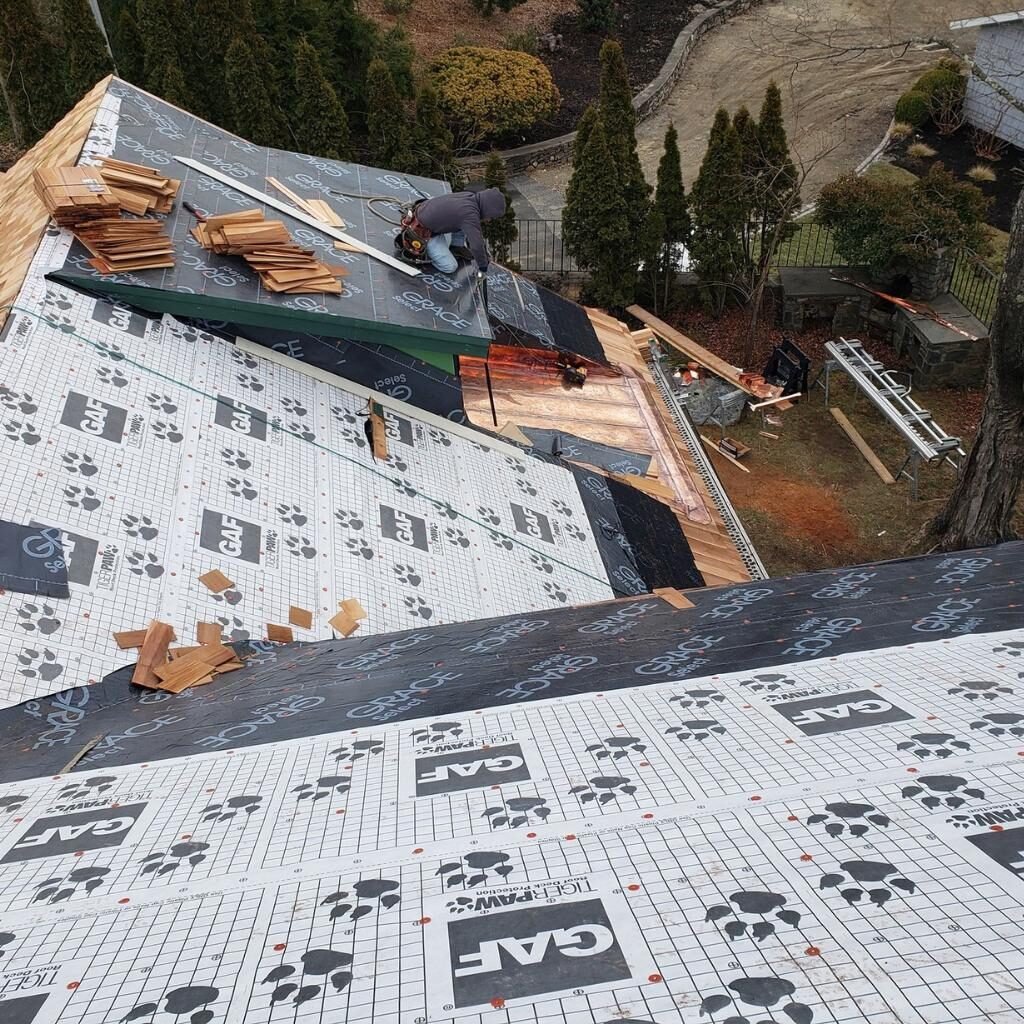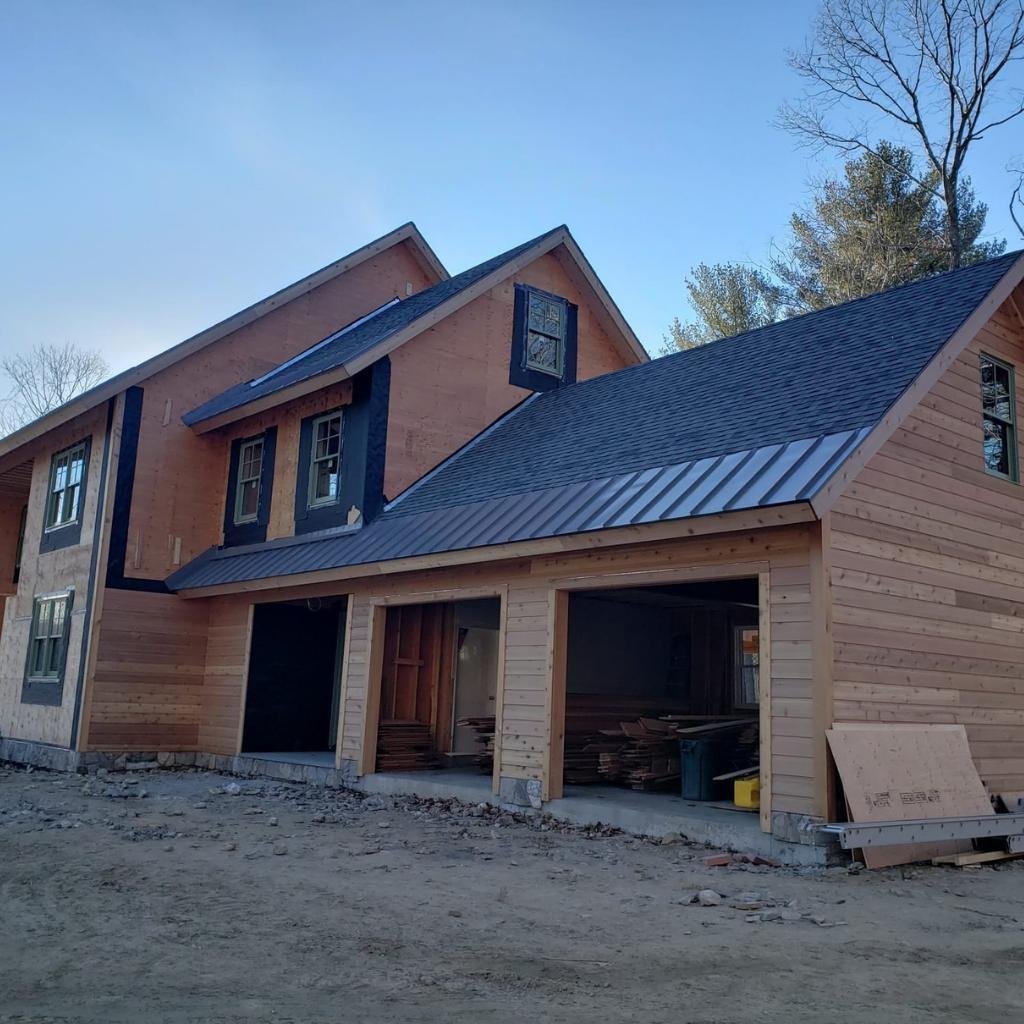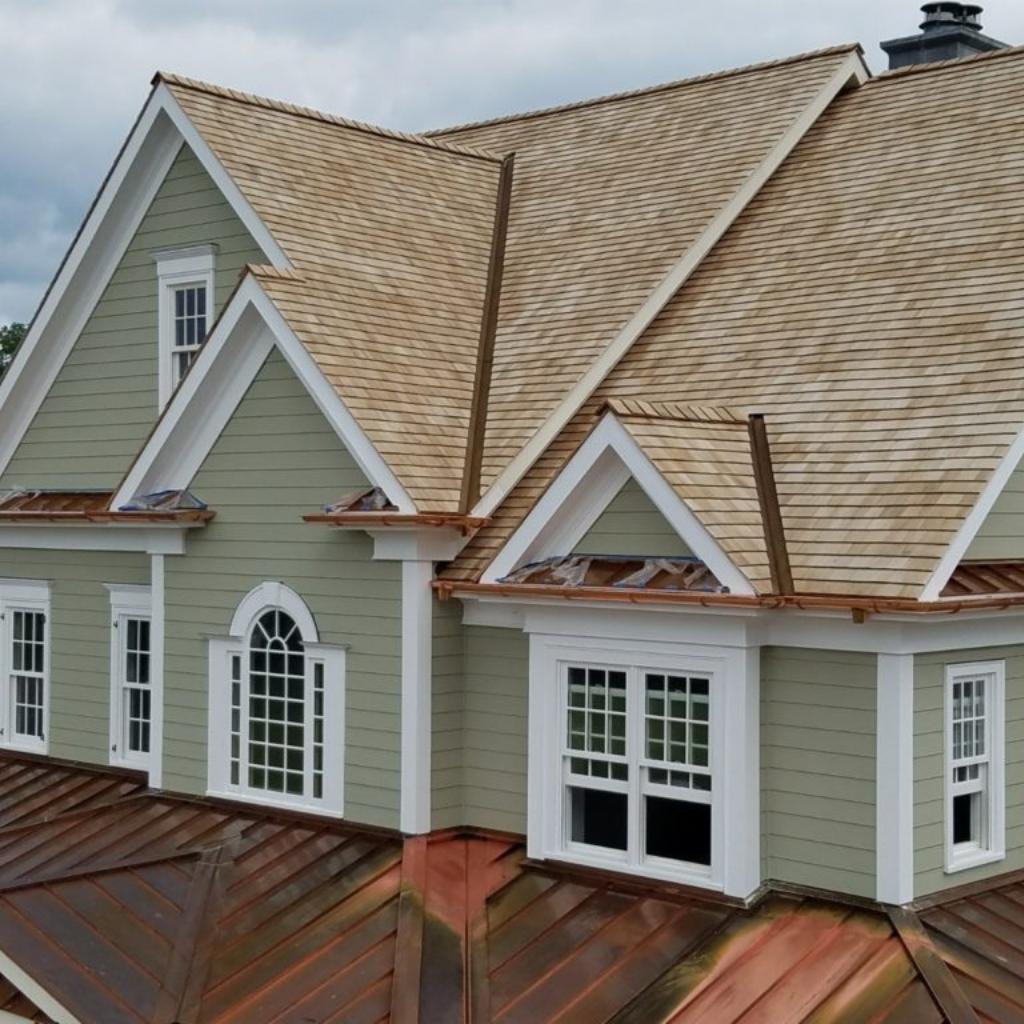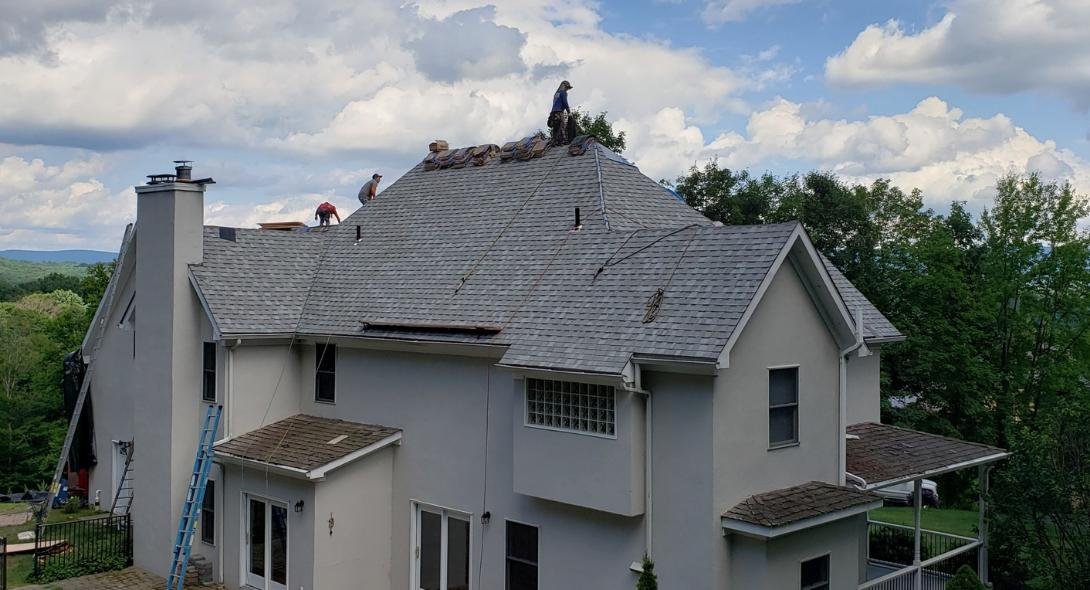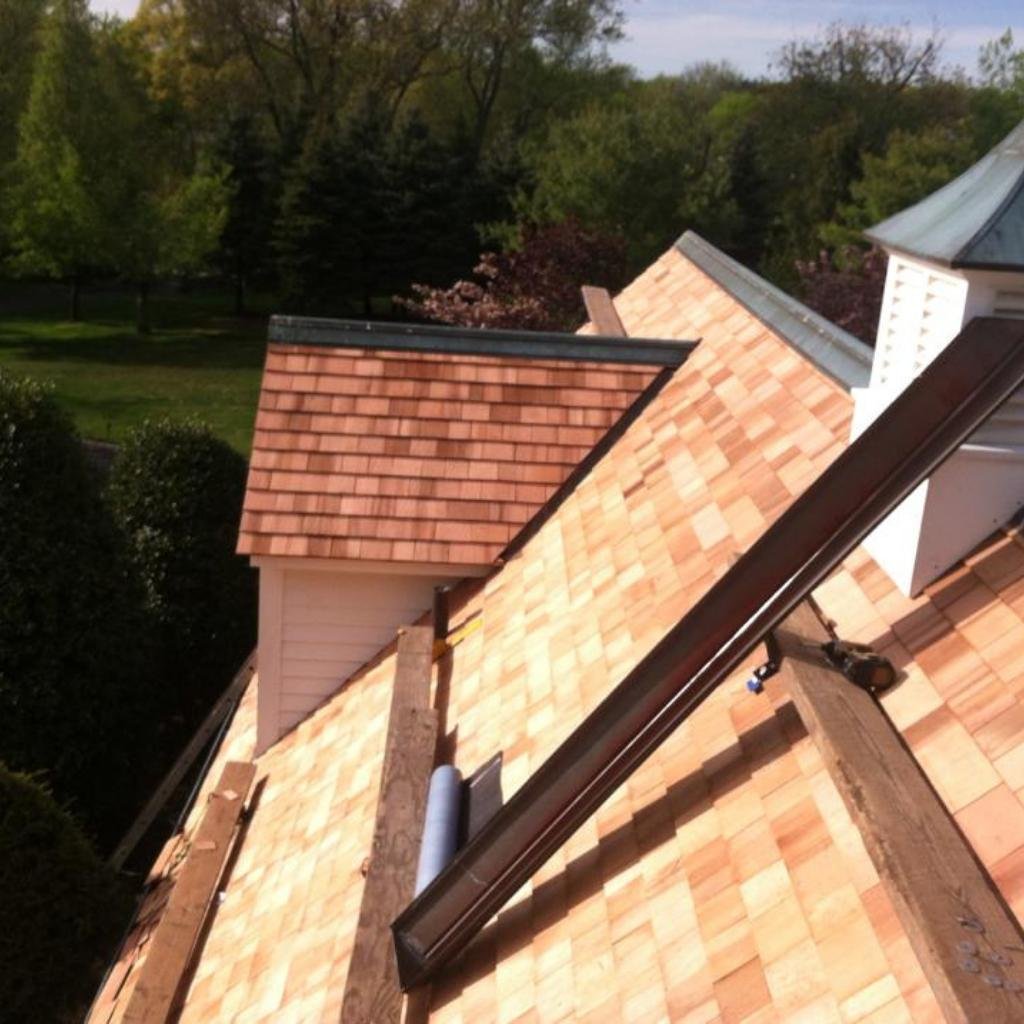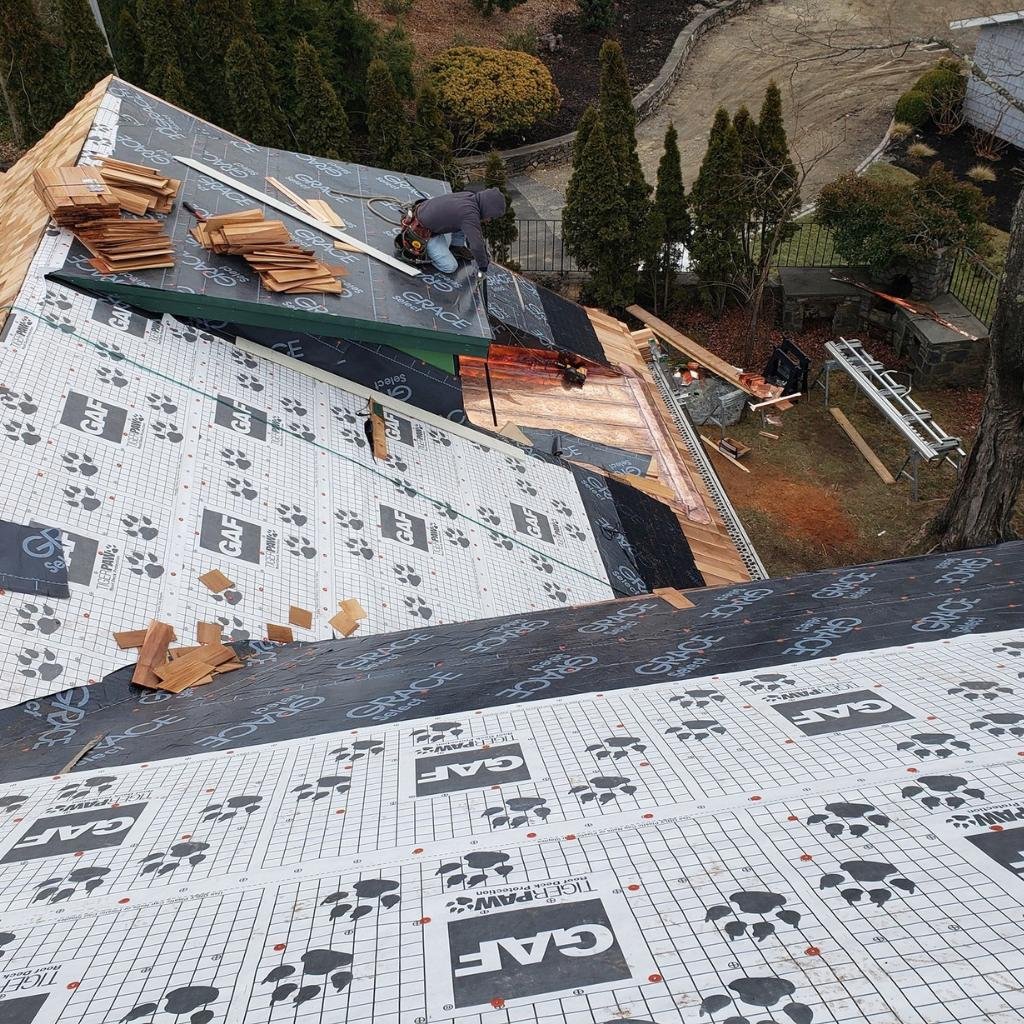Professional Wood Rot Repair for Connecticut Roofs
Wood rot represents one of the most serious threats to your roof’s structural integrity. Water infiltration, poor ventilation, and Connecticut’s humid climate create perfect conditions for wood-destroying fungi that can compromise roof decking, rafters, fascia, and other critical structural components. What begins as minor moisture exposure can progress to dangerous structural failures requiring extensive reconstruction.
At American Quality Roofing and Siding, we’ve spent over 25 years identifying and repairing wood rot throughout Connecticut. Our structural specialists understand that wood rot rarely exists in isolation. The moisture problems causing rot typically affect multiple areas, and visible damage often indicates more extensive hidden deterioration. Addressing only surface problems without eliminating moisture sources guarantees recurrence and progressive structural compromise.
Many homeowners discover wood rot only after serious damage has occurred. Soft spots, sagging roof sections, or visible decay appear when deterioration is already advanced. However, earlier warning signs exist for those who know what to look for. Our thorough inspection process identifies wood rot in all stages, from early moisture damage to severe structural compromise, ensuring comprehensive restoration that eliminates both existing problems and their underlying causes.
Connecticut’s climate accelerates wood rot through freeze-thaw cycles, high humidity, and temperature fluctuations that promote fungal growth. Materials that might resist rot for decades in drier climates can fail within years here. Our experience with Connecticut-specific conditions means we understand not just how to repair wood rot, but how to prevent its return through proper ventilation, drainage solutions, and moisture control strategies.
Free Estimates – Contact Us Today
Understanding Wood Rot
What Causes Wood Rot in Connecticut Roofs
Wood rot occurs when moisture, oxygen, and moderate temperatures combine to create ideal conditions for wood-destroying fungi. Understanding this process helps homeowners recognize risks and take preventive action.
Moisture Requirements: Fungi causing wood rot require sustained moisture content above 20% in wood fibers. Brief wetting from occasional rain doesn’t typically cause problems; it’s prolonged moisture exposure from leaks, condensation, or poor drainage that creates rot conditions. Connecticut’s humidity means wood dries slowly after moisture exposure, extending the time fungi have to establish.
Fungal Growth Patterns: Wood-destroying fungi digest cellulose and lignin in wood fibers, causing structural breakdown. Brown rot affects softwoods primarily, while white rot attacks hardwoods. Both types compromise structural strength, though damage patterns differ. Fungi spread through microscopic spores that germinate when conditions are favorable, meaning rot in one area can spread to adjacent materials.
Temperature Factors: Fungal growth occurs between approximately 40-100°F, with optimal growth around 70-85°F. Connecticut’s temperature ranges fall squarely within these parameters for much of the year. Winter freezing temporarily halts fungal activity but doesn’t kill established colonies, which resume growth when temperatures rise.
Oxygen Availability: Fungi require oxygen for growth. Submerged wood or completely saturated conditions actually prevent rot because oxygen is excluded. However, typical roof moisture conditions provide ample oxygen, allowing fungal activity to proceed. This is why poorly ventilated attics, where humid air stagnates, often experience severe rot problems.
Common Moisture Sources: Understanding where moisture originates helps prevent wood rot. Roof leaks from damaged shingles, failed flashing, or ice dams provide direct water intrusion. Condensation from inadequate ventilation creates moisture without external water sources. Gutter problems allow water to accumulate against fascia boards. Plumbing leaks in attic spaces introduce sustained moisture.
Progression Patterns: Wood rot typically begins at surfaces where moisture first contacts wood, then progresses deeper into materials and spreads to adjacent components. Early stages may show discoloration or softening. Advanced rot creates spongy or crumbly wood that has lost structural capacity. Complete failure occurs when remaining wood cannot support loads.
Dry Rot Misconception: “Dry rot” is a misnomer; all wood rot requires moisture. The term comes from advanced rot’s dry, crumbly appearance after fungi have consumed wood fibers and moisture has evaporated. However, active rot causing this damage required sustained moisture exposure.
Our specialists identify rot in all stages and trace moisture sources that created conditions for fungal growth, ensuring repairs address both damage and causes.
Signs of Wood Rot Damage
Identifying Wood Rot Before Major Failure
Early wood rot detection prevents costly structural repairs and potential safety hazards. Recognizing warning signs helps homeowners seek professional assessment before damage becomes extensive.
Visible Exterior Signs:
- Discolored or darkened wood on fascia, soffits, or exposed rafters
- Soft or spongy areas when pressing on wood surfaces
- Cracking, splitting, or crumbling wood texture
- Peeling or bubbling paint on wood trim
- Visible fungal growth, mushrooms, or mold on exterior wood
- Separated or pulling away trim boards
- Nail or screw heads protruding as wood shrinks
Roof Surface Indicators:
- Sagging roof sections or visible dips
- Soft spots when walking on roof
- Shingles appearing wavy or uneven
- Visible deck deterioration at roof edges
- Daylight visible through roof boards from attic
- Granules collecting in unusual patterns suggesting deck irregularities
Attic Warning Signs:
- Staining or discoloration on rafters or decking
- Soft or deteriorated wood when pressing on surfaces
- Musty odors indicating fungal activity
- Visible mold growth on wood surfaces
- Water stains on structural components
- White, brown, or dark fungal growth patterns
- Compressed or wet insulation near wood components
- Rust on metal fasteners or brackets
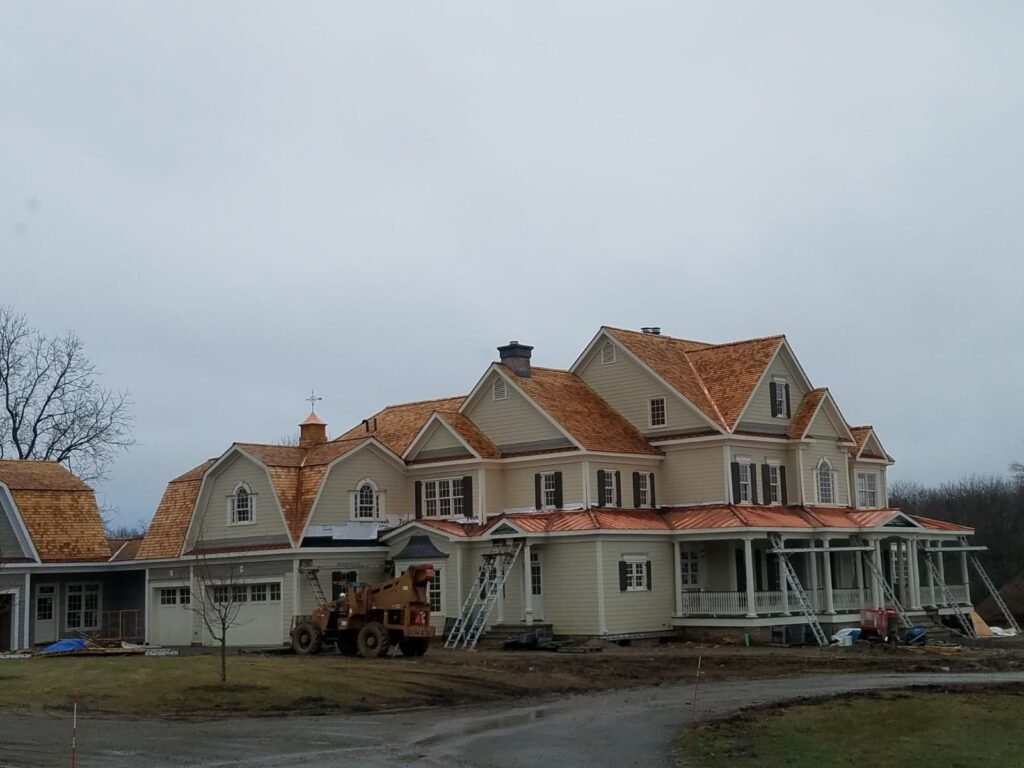
Attic Warning Signs:
- Staining or discoloration on rafters or decking
- Soft or deteriorated wood when pressing on surfaces
- Musty odors indicating fungal activity
- Visible mold growth on wood surfaces
- Water stains on structural components
- White, brown, or dark fungal growth patterns
- Compressed or wet insulation near wood components
- Rust on metal fasteners or brackets
Interior Indicators:
- Ceiling stains appearing below roof areas
- Sagging or bowing ceiling materials
- Cracks in ceiling or walls near roofline
- Paint peeling on upper floor ceilings
- Musty odors in upper floor rooms
- Visible mold on ceiling surfaces
Structural Concerns:
- Doors or windows sticking in upper floors
- Visible settling or movement in roof structure
- Unusual sounds during wind events
- Cracks in exterior walls at roofline
- Foundation settling related to roof load distribution
Seasonal Signs:
- Problems worsening after winter ice dam season
- Issues appearing after periods of high humidity
- Deterioration accelerating in spring and fall
- Temporary improvements during dry summer months
If you observe any of these indicators, professional inspection is essential. Wood rot progresses continuously once established, and early intervention prevents minor problems from becoming structural emergencies.
Health and Safety Risks From Wood Rot
Why Wood Rot Requires Immediate Attention
Wood rot creates serious health and safety hazards beyond structural concerns. Understanding these risks emphasizes the importance of prompt professional repair.
Structural Failure Risks: Rotted wood loses load-bearing capacity. Roof decking unable to support snow loads can collapse. Deteriorated rafters may fail under normal roof weight. Compromised fascia can separate completely, creating falling hazards. These structural failures pose serious injury risks to occupants and people near the building.
Mold and Health Concerns: Conditions causing wood rot also promote mold growth. Many mold species produce allergens, irritants, or mycotoxins affecting respiratory health. Prolonged exposure can cause allergic reactions, asthma exacerbation, respiratory infections, and other health problems. Children, elderly individuals, and those with compromised immune systems face particular risks.
Indoor Air Quality: Fungal spores from wood rot and associated mold circulate through homes via air currents and HVAC systems. This contamination affects indoor air quality throughout the structure, not just areas immediately adjacent to rot. Musty odors indicate significant fungal activity and spore presence.
Pest Attraction: Wood rot attracts carpenter ants, termites, and other wood-destroying insects. These pests cause additional structural damage and create secondary infestation problems. Decayed wood also provides entry points for rodents and other pests seeking shelter.
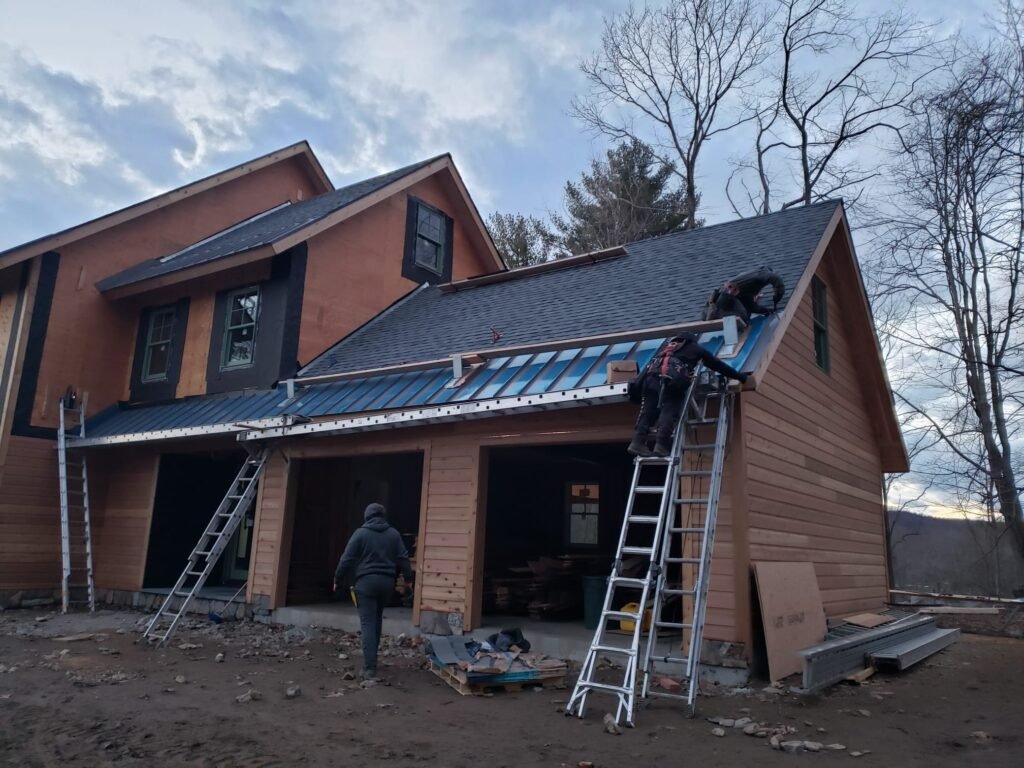
Electrical Hazards: Water causing wood rot often contacts electrical wiring, fixtures, or systems. Moisture and electricity create fire and electrocution risks. Rotted wood near electrical components compounds these dangers as structural failures can damage wiring and create additional hazards.
Progressive Damage: Wood rot spreads continuously. Untreated rot expands to adjacent structural members, increasing repair costs exponentially. What might require limited decking replacement initially can progress to complete roof reconstruction if ignored.
Property Value Impact: Significant wood rot reduces home value substantially. Buyers and inspectors view structural rot as serious problems indicating potential poor maintenance. Even after repairs, disclosure requirements and visible evidence of past problems can affect marketability and sale prices.
Insurance Complications: Some insurance policies exclude coverage for damage resulting from long-term maintenance neglect. Allowing wood rot to progress unchecked may jeopardize coverage for resulting failures. Prompt attention to moisture problems and visible rot helps maintain insurance protection.
Our comprehensive approach addresses both immediate rot damage and underlying causes, eliminating health risks and preventing structural hazards while protecting your property investment.
quality Services
We Provide Quality
Roofing Services Throughout CT
5 Star Reviews
Projects
Teams available
Free Estimate – Contact Us Today
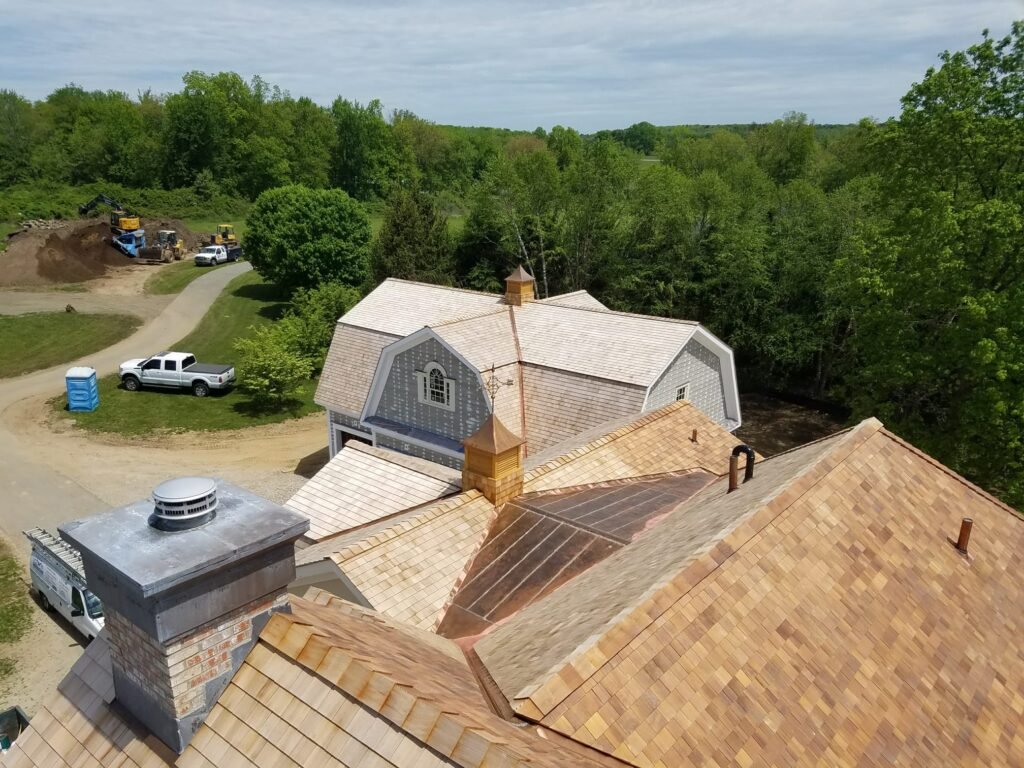
Connecticut Climate and Wood Rot
Why Connecticut Roofs Face Unique Rot Challenges
Connecticut’s climate creates particularly favorable conditions for wood rot. Understanding these regional factors explains why local expertise matters for proper repair and prevention.
High Humidity Levels: Connecticut experiences elevated humidity throughout much of the year, particularly spring through fall. Humid air in poorly ventilated attics creates condensation on cool roof deck surfaces. This moisture allows fungal growth without external water intrusion, meaning rot can develop even with leak-free roofs.
Freeze-Thaw Cycles: Connecticut’s temperature fluctuations cause repeated freezing and thawing of moisture trapped in wood. Ice expansion during freezing physically damages wood fibers, creating cracks and openings that accelerate subsequent moisture absorption. This mechanical damage compounds fungal deterioration.
Ice Dam Formation: Connecticut winters produce perfect ice dam conditions. Heat escaping through inadequately insulated ceilings melts roof snow. Water runs to cold eaves and refreezes, creating ice barriers that force water under shingles. This prolonged moisture exposure saturates roof decking, creating extensive rot in fascia, soffits, and deck edges.
Extended Wet Seasons: Spring often brings prolonged rainy periods where roofs remain damp for weeks. Fall similarly produces extended moisture exposure. These sustained wet conditions provide the continuous moisture fungi require, unlike brief rain events that dry quickly.
Nor’easter Impact: These powerful storms bring not just wind and precipitation but sustained exposure to horizontal, wind-driven rain that penetrates areas typically protected from vertical rainfall. Moisture infiltrates through vulnerabilities that wouldn’t fail during normal rain, creating rot in unexpected locations.
Coastal Salt Air: Connecticut’s coastal regions face additional challenges from salt-laden air that corrodes metal fasteners and flashing. Corroded fasteners lose holding capacity, allowing shingles to lift and moisture to enter. Failed flashing creates direct water paths to wood components.
Seasonal Temperature Swings: Dramatic temperature changes between seasons cause repeated expansion and contraction of all roofing materials. These movements open microscopic gaps in seals and connections, creating moisture entry points that gradually worsen until significant leaks develop.
Poor Air Circulation Periods: Hot, humid summer days followed by cool nights create significant temperature differentials. Without adequate ventilation, warm, moist air contacts cool roof deck surfaces, causing condensation that saturates wood. This condensation-driven rot occurs without any external water source.
Our 25 years of Connecticut experience means we understand these regional factors and implement solutions specifically designed for our climate’s unique challenges.
Wood Rot Inspection Process
How We Identify All Wood Rot Damage
Thorough wood rot assessment requires systematic inspection techniques and understanding of where problems typically develop. Our comprehensive process ensures no damage goes undetected.
Visual Exterior Examination: We inspect all visible exterior wood components including fascia, soffits, rake boards, and exposed rafter tails. We look for discoloration, texture changes, fungal growth, paint failure, and other rot indicators. This examination identifies obvious problems and guides interior investigation.
Moisture Detection: We use moisture meters to measure water content in wood components. Readings above 20% indicate conditions supporting fungal growth. Identifying moisture patterns helps locate active rot even when visible decay hasn’t appeared.
Structural Probing: We probe suspect areas with specialized tools to assess wood integrity. Soft, spongy, or easily penetrated wood indicates active rot. Probing depth reveals how far decay has progressed into structural members.
Attic Inspection: Comprehensive attic examination reveals hidden rot not visible from exterior. We inspect rafters, decking, wall plates, and all structural wood for staining, discoloration, texture changes, and visible fungal growth. Attic inspection often reveals the full extent of damage visible signs only suggested.
Ventilation Assessment: We evaluate attic ventilation adequacy since poor airflow causes condensation leading to rot. Calculating ventilation ratios and observing airflow patterns identifies whether inadequate ventilation contributes to moisture problems.
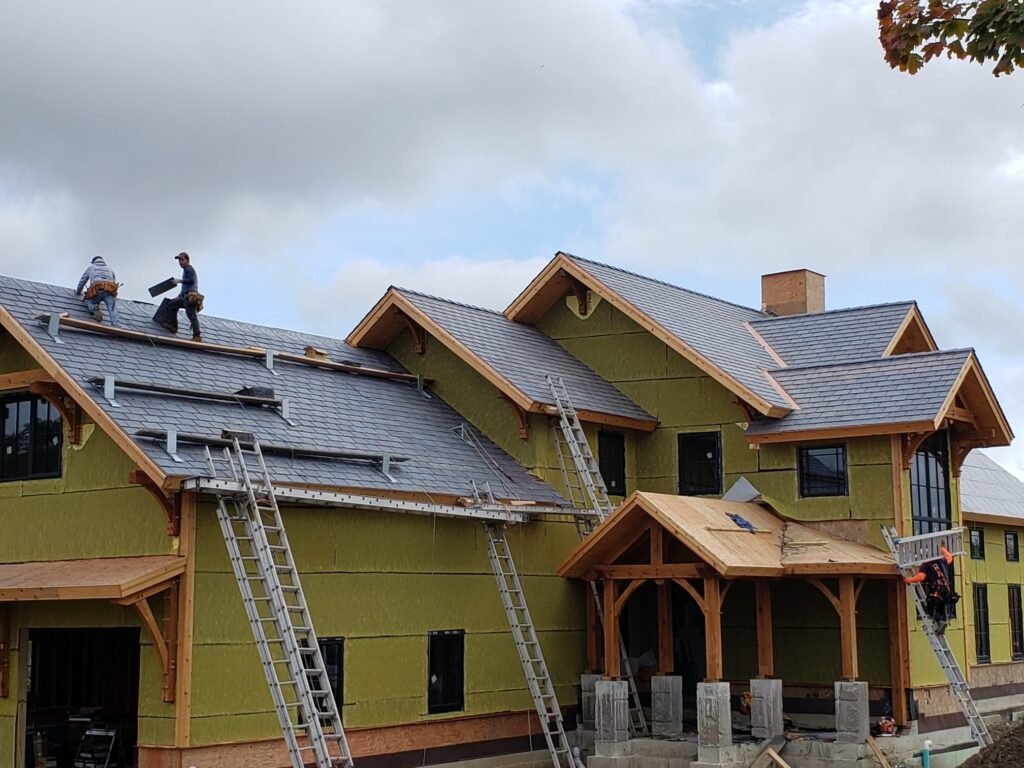
Insulation Evaluation: We examine insulation for compression, moisture damage, or improper installation that promotes condensation. Wet or compressed insulation indicates moisture problems likely causing or accompanying wood rot.
Leak Source Identification: We identify all water entry points contributing to rot. This includes damaged shingles, failed flashing, ice dam evidence, and penetration leaks. Eliminating moisture sources is essential for preventing rot recurrence.
Hidden Damage Investigation: We check behind visible materials when rot indicators suggest hidden problems. Removing sections of damaged materials reveals the full extent of decay and ensures comprehensive repair planning.
Documentation: We photograph all damage, document findings in detailed reports, and map affected areas. This documentation supports insurance claims if applicable and provides clear records of existing problems and necessary repairs.
Structural Assessment: For severe rot, we evaluate remaining structural capacity and determine whether temporary support is needed during repairs. This assessment ensures safety throughout the restoration process.
Our thorough inspection process identifies not just obvious rot but the full extent of damage and all contributing factors, ensuring complete restoration rather than superficial repairs.
Wood Rot Repair Process
Complete Structural Restoration
Wood rot repair requires more than replacing damaged wood; it demands eliminating moisture sources and preventing recurrence. Our comprehensive approach provides lasting solutions.
Moisture Source Elimination: Before replacing rotted wood, we address all moisture entry points. This includes repairing roof leaks, correcting drainage problems, improving ventilation, and fixing any conditions that allowed rot to develop. Replacing wood without eliminating moisture guarantees recurrence.
Damage Removal: We remove all rotted wood, cutting back to solid material. Attempting to repair partially decayed wood or leaving soft sections is inadequate; compromised wood must be completely removed to ensure structural integrity and prevent rot spread.
Adjacent Area Treatment: We treat solid wood adjacent to rotted sections with fungicidal products that inhibit future growth. This treatment provides additional protection in areas that experienced moisture exposure but haven’t yet developed visible decay.
Structural Replacement: We install new structural members using pressure-treated or naturally rot-resistant materials appropriate for each application. All lumber is properly sized to match or exceed original structural capacity. We use corrosion-resistant fasteners that won’t fail from moisture exposure.
Ventilation Improvements: If poor ventilation contributed to rot, we implement improvements ensuring adequate airflow. This may include adding soffit vents, ridge vents, or attic fans. Proper ventilation prevents condensation that causes rot even with leak-free roofs.
Drainage Corrections: We address gutter problems, poor roof drainage, or other water management issues that contributed to rot. Proper water diversion prevents moisture accumulation against wood components.
Insulation Optimization: We replace wet or damaged insulation and ensure proper installation that prevents condensation. Air barriers between conditioned and unconditioned spaces reduce moisture migration to attic areas.
Flashing Restoration: We repair or replace all flashing in areas affected by rot. Proper flashing installation prevents water intrusion that caused original damage and protects new structural components.
Protective Treatments: We apply appropriate primers and paints or stains to all exposed wood, creating barriers against moisture absorption. These protective coatings extend wood life and provide early warning if future moisture problems develop.
Quality Verification: We inspect all work thoroughly, verify structural integrity, confirm moisture sources are eliminated, and ensure protective measures are properly implemented. Our restoration addresses both existing damage and prevents future problems.
Preventing Future Wood Rot
Protecting Your Roof from Wood Rot
Prevention is far more cost-effective than repairing established wood rot. Implementing protective strategies significantly reduces rot risk and extends your roof’s lifespan.
Annual Professional Inspections
Proper Attic Ventilation
Gutter Maintenance
Prompt Leak Repairs
Insulation Best Practices
Ice Dam Prevention
Flashing Maintenance
Paint and Sealant Maintenance
Tree and Vegetation Management
Don’t Delay Professional Repair
Our Wood Rot Repair Process
Professional Structural Restoration
Our systematic approach ensures complete wood rot elimination and prevents recurrence through comprehensive moisture control.
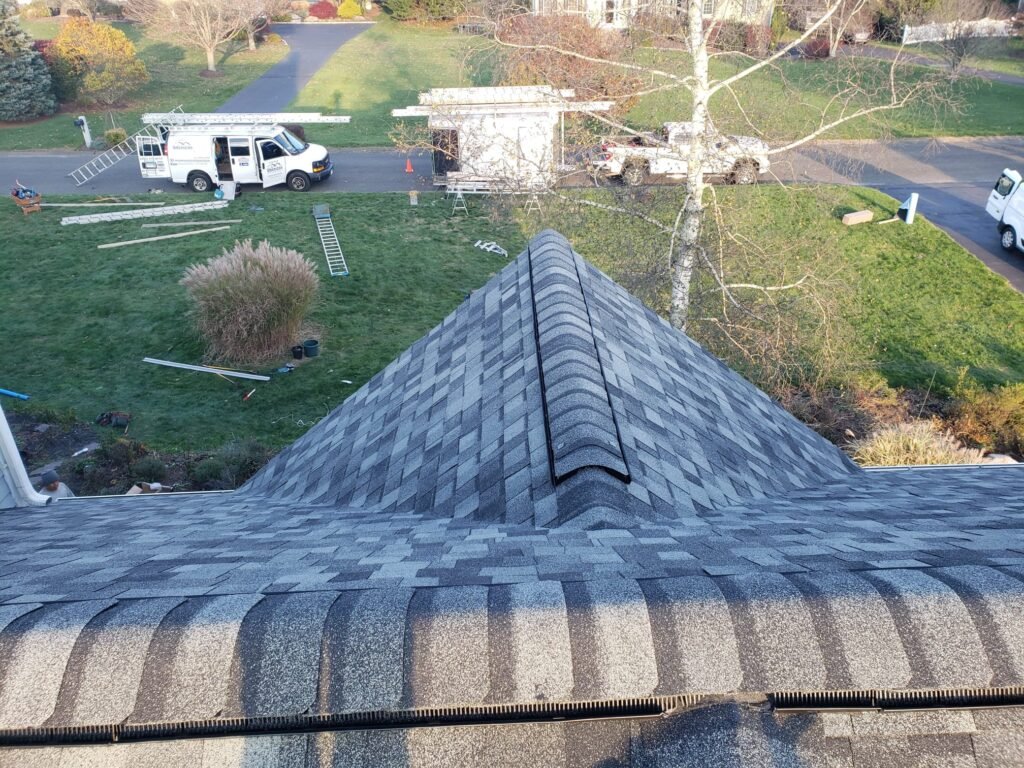
Comprehensive Rot Assessment
Our structural specialists conduct thorough inspection of all roof components, identifying visible rot, hidden damage, and moisture sources. We document all findings and determine the full scope of necessary repairs.
Moisture Source Identification
We identify every moisture entry point contributing to rot, including leaks, condensation, drainage problems, and ventilation inadequacies. Eliminating these sources is essential for preventing rot recurrence.
Detailed Repair Planning
Based on assessment findings, we develop comprehensive repair specifications detailing all structural work, moisture control improvements, and preventive measures. You’ll understand exactly what will be done and why each component is necessary.
Complete Rot Removal
We remove all rotted wood, cutting back to solid material. Thorough removal is essential; leaving any compromised wood guarantees continued problems and potential structural failures.
Structural Restoration
We install new structural components using appropriate rot-resistant materials. All work meets or exceeds building codes and restores full structural capacity. We implement enhanced moisture protection measures during installation.
Ventilation and Drainage Improvements
We correct ventilation inadequacies, improve drainage, and implement moisture control strategies preventing future rot. These improvements are as important as structural repairs for long-term protection.
Final Verification and Protection
We inspect all work thoroughly, verify structural integrity, confirm moisture sources are eliminated, and apply appropriate protective treatments. Our warranty covers both materials and workmanship, providing long-term peace of mind.
Why Choose Us for Wood Rot Repair
Connecticut’s Structural Restoration Experts
25 Years of Structural Experience: Since 1999, we’ve repaired wood rot in thousands of Connecticut homes. This extensive experience means we recognize rot patterns, understand Connecticut-specific moisture problems, and know how to provide lasting solutions.
Complete Moisture Control Expertise: We don’t just replace rotted wood; we eliminate the moisture problems that caused rot and implement preventive measures ensuring problems don’t return. This comprehensive approach provides true solutions rather than temporary fixes.
Structural Engineering Knowledge: Our team understands structural requirements and proper restoration techniques. We ensure repairs restore full load-bearing capacity and meet all building code requirements for safety and performance.
Factory-Certified Installation: Our certifications with GAF Materials Corporation and as ShingleMaster™ CertainTeed Select contractors ensure we understand complete roofing systems. This knowledge is essential for addressing all factors contributing to wood rot.
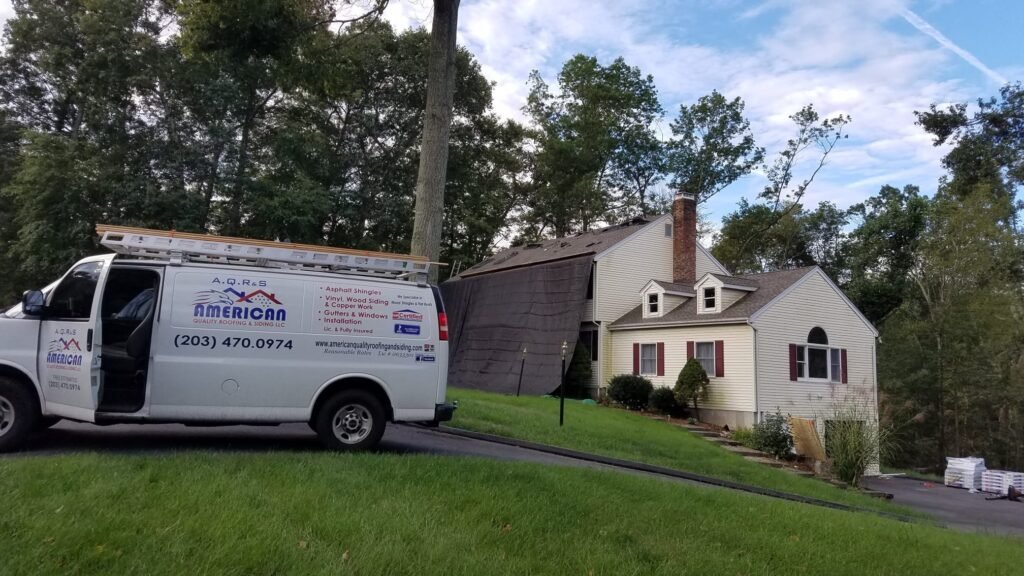
Honest Assessment: We provide truthful evaluation of rot extent and necessary repairs. If minor repairs suffice, we recommend them. If extensive work is necessary, we explain why. Our reputation depends on honest guidance rather than overselling services.
Quality Materials: We use appropriate rot-resistant materials for each application, including pressure-treated lumber, naturally resistant species, and corrosion-resistant fasteners. Quality materials provide long-term performance Connecticut’s climate demands.
Licensed and Insured Protection: Connecticut License #HIC 0633301 and comprehensive insurance coverage protect you throughout restoration. This licensing and insurance provides accountability and security for structural work.
Comprehensive Warranty: All wood rot repairs include warranty coverage for materials and workmanship. This protection demonstrates our confidence in repair quality and moisture control effectiveness.
FAQs
Common Questions About Wood Rot Repair
Wood rot raises important questions about repair approaches, costs, and prevention. Over our 25 years serving Connecticut families, we’ve helped hundreds of homeowners address structural rot problems and implement preventive measures. Below are the most common concerns homeowners have about wood rot in their roofs. If you don’t see your specific question answered here, our team is always available to provide personalized guidance for your situation.
Don’t Let Wood Rot Compromise Your Home’s Safety
Wood rot progressively worsens, causing increasing structural damage and safety risks. What begins as minor moisture damage can escalate to dangerous structural failures requiring extensive reconstruction.
Our wood rot specialists provide thorough assessment, complete structural restoration, and comprehensive moisture control preventing recurrence. With over 25 years of experience and 778+ successfully completed projects, we have the expertise to address wood rot at any stage and implement lasting solutions.
We eliminate not just the rotted wood but the moisture problems that caused deterioration, ensuring your repairs last and your home remains structurally sound.
- Licensed and Insured – CT #HIC 0633301
- Factory Certified by GAF Materials Corporation
- ShingleMaster™ CertainTeed Select Contractors
- A+ Better Business Bureau Rating

